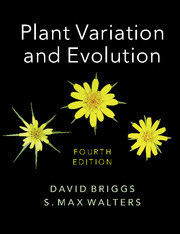Book contents
- Frontmatter
- Contents
- Preface to the Fourth Edition
- Acknowledgements
- Note on names of plants
- List of abbreviations
- 1 Investigating plant variation and evolution
- 2 From Ray to Darwin
- 3 Early work on biometry
- 4 Early work on the basis of individual variation
- 5 Post-Darwinian ideas about evolution
- 6 DNA: towards an understanding of heredity and molecular evolution
- 7 Breeding systems
- 8 Intraspecific variation and the ecotype concept
- 9 Pattern and process in plant populations
- 10 Pattern and process: factors interacting with natural selection
- 11 Populations: origins and extinctions
- 12 Species and speciation: concepts and models
- 13 Allopatric speciation and hybridisation
- 14 Abrupt speciation
- 15 The species concept
- 16 Flowering plant evolution: advances, challenges and prospects
- 17 Historical biogeography
- 18 The evolutionary impact of human activities
- 19 The taxonomic challenge ahead
- 20 Conservation: from protection to restoration and beyond
- Glossary
- References
- Index
14 - Abrupt speciation
Published online by Cambridge University Press: 05 June 2016
- Frontmatter
- Contents
- Preface to the Fourth Edition
- Acknowledgements
- Note on names of plants
- List of abbreviations
- 1 Investigating plant variation and evolution
- 2 From Ray to Darwin
- 3 Early work on biometry
- 4 Early work on the basis of individual variation
- 5 Post-Darwinian ideas about evolution
- 6 DNA: towards an understanding of heredity and molecular evolution
- 7 Breeding systems
- 8 Intraspecific variation and the ecotype concept
- 9 Pattern and process in plant populations
- 10 Pattern and process: factors interacting with natural selection
- 11 Populations: origins and extinctions
- 12 Species and speciation: concepts and models
- 13 Allopatric speciation and hybridisation
- 14 Abrupt speciation
- 15 The species concept
- 16 Flowering plant evolution: advances, challenges and prospects
- 17 Historical biogeography
- 18 The evolutionary impact of human activities
- 19 The taxonomic challenge ahead
- 20 Conservation: from protection to restoration and beyond
- Glossary
- References
- Index
Summary
The processes of allopatric speciation discussed in Chapter 13 ‘may be responsible for many, if not most, speciation events’ (Soltis & Soltis, 2009). However, new species also arise abruptly in a sympatric context, often as a consequence of species hybridisation, the ‘evolutionary signature’ of which is ‘rampant’ in many groups of plants (Soltis & Soltis, 2009). In this chapter, our account will reflect the major change of outlook that has emerged in the study of abrupt speciation processes. For example, Stebbins (1971) considered that ‘polyploidy has contributed little to progressive evolution’. This view has been replaced by a radically different ‘consensus view that polyploidy is a prominent force in plant evolution’ (Wendel & Doyle, 2005).
Our present understanding of abrupt speciation is explored in three sections:
A. The emergence and testing of key concepts in the study of polypoidy
B. Recent insights into polyploidy from molecular studies
C. Other modes of abrupt speciation
A. The emergence and testing of key concepts in the study of polypoidy
For close on 100 years, botanists have been investigating abrupt speciation by polyploidy. Using the techniques available (and fashionable) in different periods, hypotheses about polyploid speciation have been tested. We consider the successes and limitations of the various approaches from cytogenetical and karyological methods (first developed in the nineteenth century), to chemical investigations of the 1960s. In presenting a number of case histories we review the emergence of key concepts and consider how early findings have been tested, confirmed, refined and extended by the use of an increasing range of molecular methods.
The concept of polyploidy: early cytogenetic studies
As we saw in Chapter 12, Winge's (1917) hypothesis that fertile derivatives could be derived from sterile hybrids by polyploidy was tested in a number of experimental studies.
A famous case of allopolyploidy was provided by Primula kewensis, which was discovered amongst seedlings of P. floribunda at Kew in 1899. The proposition that P. kewensis was a hybrid between P. floribunda and P. verticillata was put to the test by making the hybrid experimentally, using P. floribunda as female parent. P. kewensis was morphologically intermediate between the parental stocks and had the same chromosome number 2n = 18 (Digby, 1912; Newton & Pellew, 1929).
Information
- Type
- Chapter
- Information
- Plant Variation and Evolution , pp. 287 - 330Publisher: Cambridge University PressPrint publication year: 2016
